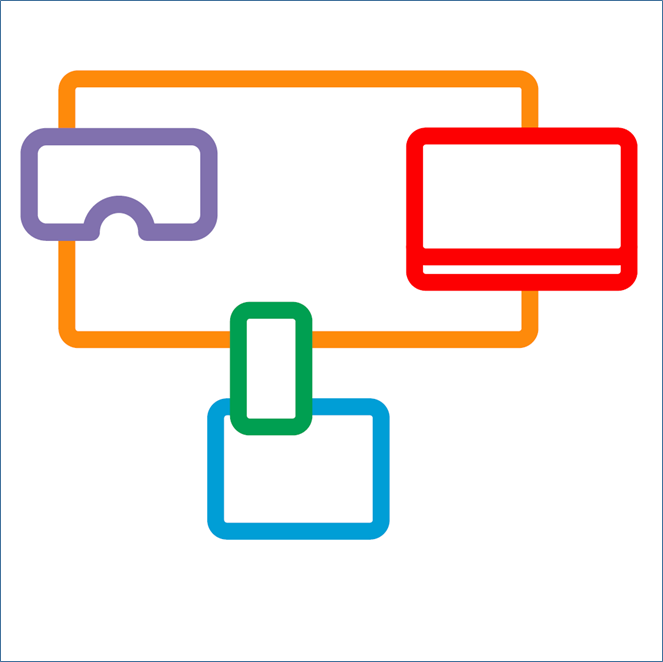Back of the net!
The 2-IMMERSE Football production team report on the success of our major trial at Wembley.
2-IMMERSE passed another milestone at the recent 2018 FA Cup Final at Wembley Stadium between Chelsea and Manchester United as we proved our prototype end-to-end live production system for object-based broadcasting to multiple screens.
For those that may not know the FA Cup is the world’s oldest football challenge cup, having been started back in 1871. The high profile final is the curtain closer for the UK domestic football season and has spawned and fuelled many of the intense inter club rivalries that give the UK league its particular character. For decades the match has also been a key television moment and a showcase for experimentation and innovation in the presentation of football on television. So 2-IMMERSE is very proud this year to have been a small part of a great tradition. The FA Cup Final is a national treasure, but it also draws a global audience estimated to be in the hundreds of millions.
Our team for the FA Cup was drawn from BT, CWI, Cisco, and BBC R&D – and they all worked tirelessly over the preceding weeks and months to design and develop the end-to-end system. Early ‘sighting visits’ to Wembley (see our previous blog post) helped us identify and address the key issues that can affect the delivery of the service and helped the test on the day of the Final to go as smoothly as it did.
On the day, we arrived with our modest broadcast truck and once the feeds from all the individual cameras were in place we were set to go. After all the preparation we were able to conduct three key activities at Wembley:
- Live orchestration of match graphics, mirroring the broadcast graphics production but using our own HTML 5 focused production and delivery chain
- Live monitoring and demonstration of prototype Football DMApp (see blog post) on site at Wembley
- ChyronHego data capture for Virtual Placement: camera parametric data and Tracab player tracking data.
In addition to the on-site achievements, and to further illustrate the end-to-end nature of the trial, we engaged 10 remote viewing participants in UK, Sweden and the Netherlands, to experience watching our interactive, customisable and multi-screen version of the 2018 FA Cup Final.
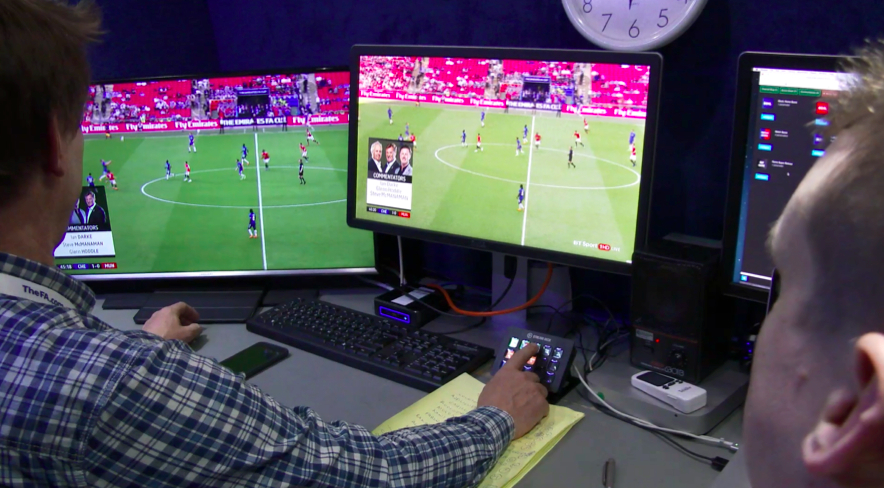
Among the key system elements and features of our system are the following (which will be illustrated in a short video coming soon):
- Live triggering tool with trigger launcher driven by Elgato Streamdeck
- Real-time preview in OB van driven direct from SDI
- TV emulator and Samsung tablet as client devices
- Live sessions integrated within client onboarding workflow
- Match GFX components developed by ChyronHego and implemented using new DMApp component which integrates with their Prime universal graphics platform.
- Interactive experience on tablet included:
- ScoreClock menu with match overview, team line-ups and replays
- Broadcast menu with camera feed viewer and customised picture-in-picture layout on TV
Like most productions this was a massive collaboration involving people and organisations across and beyond 2-IMMERSE. We are happy to acknowledge the help of: AWS Elemental in providing real-time encoders; BT Technology Service and Operations for providing some key with contacts and helping with system design; BT Sport for permission to access the stadium and allowing our small van to take its place alongside the big trucks from BT Sport and the BBC; and to BT Sport and BT media and broadcast for providing the guaranteed upstream bandwidth we needed.
The next step – or at least one of them – is to work with all the video and data captured at the Final to develop a stand-alone demo showing the capabilities of the system and illustrating the end-to-end process. We will present this on our stand in the Future Zone at IBC 2018 in Amsterdam in September. We look forward to seeing you there.
READ MOREMaking it into ‘Making it happen’
BT Group plc has just published its latest annual report for the year ended 31 March 2018, a .pdf of which is available here. This is a hefty document primarily for shareholders detailing the activities of the telecommunications and technology giant, including the research and development operation that is a 2-IMMERSE partner. We are delighted that on page 38 2-IMMERSE is one of two BT R&D projects highlighted in the report. Under the heading ‘Making it interactive with MotoGP’ our 2-IMMERSE prototype is illustrated and described like this:
We’re researching new forms of TV production that enable content producers to offer better multi-screen interaction. Viewers can control and personalise what they watch across TVs, tablets and smartphones. This could include extra graphics, or split audio and video, depending on the viewer’s focus.
We could hardly have put it better ourselves!
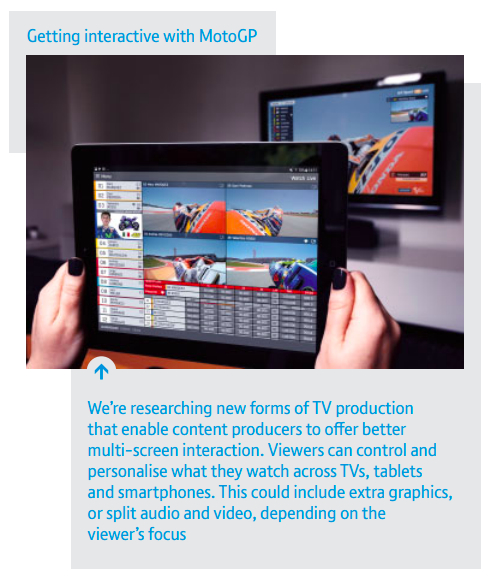
Wins for Chelsea and 2-IMMERSE at Wembley
A report from our man on the terraces, DOUG WILLIAMS from BT R&D:
2-IMMERSE is developing a live service prototype based on football that we aim to test at the FA Cup final on 19 May this year. Several 2-IMMERSE project participants gave up this last weekend to take part in key technical tests to prepare for that event. The test took place at Wembley Stadium during the FA Cup semi-final between Chelsea and Southampton.

Getting experience of all that is required for the Wembley trial incorporates a number of fundamental and non-trivial milestones, including knowing what we have to do get access to Wembley with our own outside broadcast truck, knowing what we have to do to accept all the live feeds from the cameras in the stadium, and what we have to do to make the uplink work.
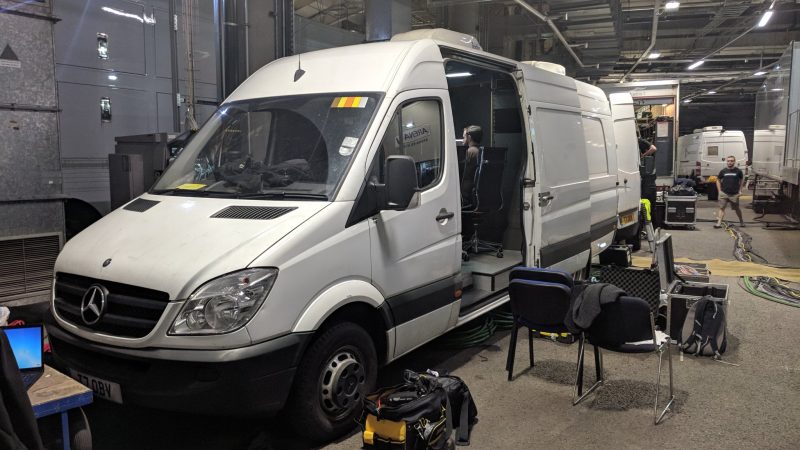
For most of the 73,000 in attendance the key question was, “Who would book their place in the final against Man United?” Our team members were much were less concerned about the result on the field. They were worried by the result on the screens.
The truck we used, thanks to the invaluable assistance of BT Sport, allowed us to test in a live environment a range of tools and systems that have been developed by the project. We learned an enormous amount by being in the middle of a major outside broadcast and through meeting a number of suppliers and colleagues who were centrally involved in delivering it.
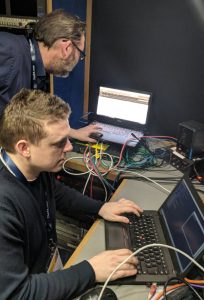
We were thrilled that the 2-IMMERSE was recognised and supported – and importantly that we are now better known to some of the outside broadcast teams whose support we will rely on for our next two live tests. Inevitably, and as you would expect from such a test, we spotted a range of bugs and problems, and we are now busy examining the logs to see if we can identify their causes – and the mend them.
While our team went home with a bug list and deeper knowledge of how the outside broadcast process interacts with our system, Chelsea went home victorious. So the FA Cup final that we will be using in our live trials on Saturday 19 May will be between Manchester United and Chelsea. Prior to that, as the footballers get measured for their match-day suits, we have some bug fixing to attend to and, thankfully, another live test to complete before we conduct a pioneering object based broadcast test of the 137th FA Cup final.
With thanks to Martin Trimby for the photographs.
READ MOREMotoGP – “nearly there”
DOUG WILLIAMS from BT R&D reports on our first user testing for the 2-IMMERSE MotoGP prototype:
Back in November 2017 we started evaluation of our MotoGP service prototype with people (real, ordinary people!) who were using it in their own home. The MotoGP service prototype is a multi-screen experience delivered via our cloud based micro-service infrastructure. The key group whose opinion we sought was people who already watch MotoGP on TV, and we wanted their feedback about our new multi-screen experience. (If you’re not familiar with our MotoGP experience you can see our video of it here.)
The results from the first 85 respondents are in and we are beginning to get to grips with the mountain of data and comments. We are, our users tell us, nearly there.
We asked our users to assess the value of the features we provide on a scale of 1-10 (where 10 is good). The details of all the features are described here.
Overall, the results are very encouraging. We sought evaluations of the different features we offered and for each participant to comment on their ease of use. As can be seen in the graphic below, scores approached 9/10 for all features – from which we have to conclude that we have done something right.
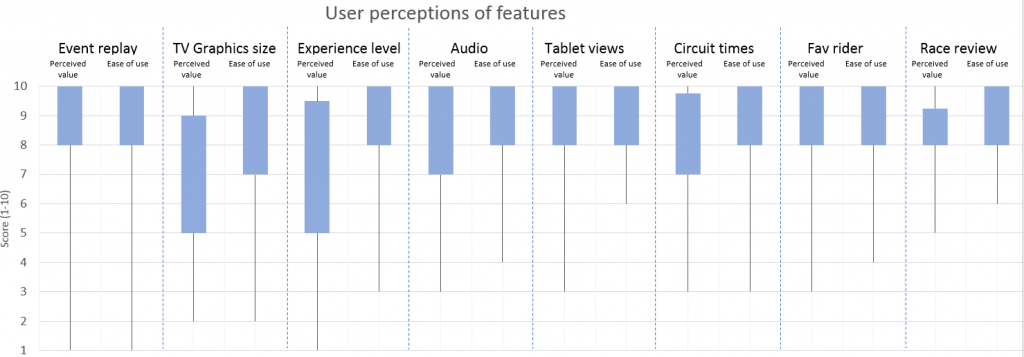
No, not everything was perfect. Some users experienced absolute failures (it is a prototype); some found the joining process a little tricky:
getting the sequencing right connecting the right thing to the right WiFi at the right time was a bit of a faff.
Some thought the responsiveness could be better, and some wanted an ‘undo’ capability. Also when asked about the level of control users had in our prototype, 88% said they wanted more control over how the video and graphics were laid out across all the screens.
The prototype, our users told us, was not perfect. Certain features that we were really keen on, such as the ability to adjust the graphics size so they better suit the size of your TV, and the ability to change the way the leaderboard was presented were, in terms of perceived value, ranked towards the bottom of the 8 broad features we assessed.
Overall, however, 9 out of 10 for all features is feels very positive. And feedback like this is very encouraging:
I would just say it’s worth getting. Really good for MotoGP… this is the future of TV… [I] don’t expect to watch [MotoGP] the same way again.
User feedback in projects like this is essential, but it is not the whole story. Feedback from the production industry is also critical – and that’s why we recently took the MotoGP to NAB. See this post to read about what industry insiders thought.
READ MOREMore things to come
Our earlier post detailed the The Future of TV conference at the Tommy Flowers Institute at BT’s Adastral Park on 6 and 7 March this year. 2-IMMERSE members have been very involved in the planning of this, and several of us are speaking and chairing sessions. The programme has just been finalised, and is featured below.
Registration is free and is available here.
tfi-spring-18-agenda-v2 READ MOREThings to come
JOHN WYVER writes: In just under a month, on 6 and 7 March, the Tommy Flowers Institute at BT’s Adastral Park is hosting ‘The Future of TV’, a two-day conference for post-graduate researchers and industry experts about quite what television is today and where it’s headed. Members of the 2-IMMERSE group have been centrally involved in the planning of the event, both James Walker from Cisco and I will be presenting at it, and BT’s Doug Williams and Ian Kegel will be chairing sessions. Other BT colleagues will be involved in break-out sessions and panels. A key objective for 2-IMMERSE is to highlight the opportunities which we believe object-based broadcasting can provide for the television industry. Attendance is free and you can sign up for it here.
READ MORE
